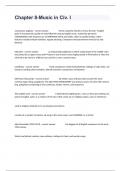Exam (elaborations)
Chapter 8-Music in Civ. I Exam With Explanation Of Answers 100% Correct.
- Course
- Institution
contenance angloise - correct answer Terms coined by Martin Le Franc.(French, "English guise") Characteristic quality of early-fifteenth-century English music, marked by pervasive CONSONANCE with frequent use of HARMONIC thirds and sixths, often in parallel motion. Other features...
[Show more]



